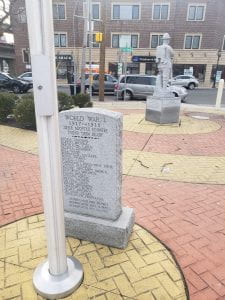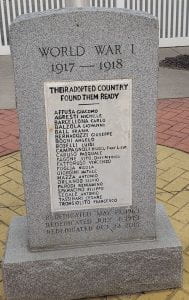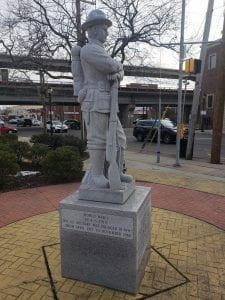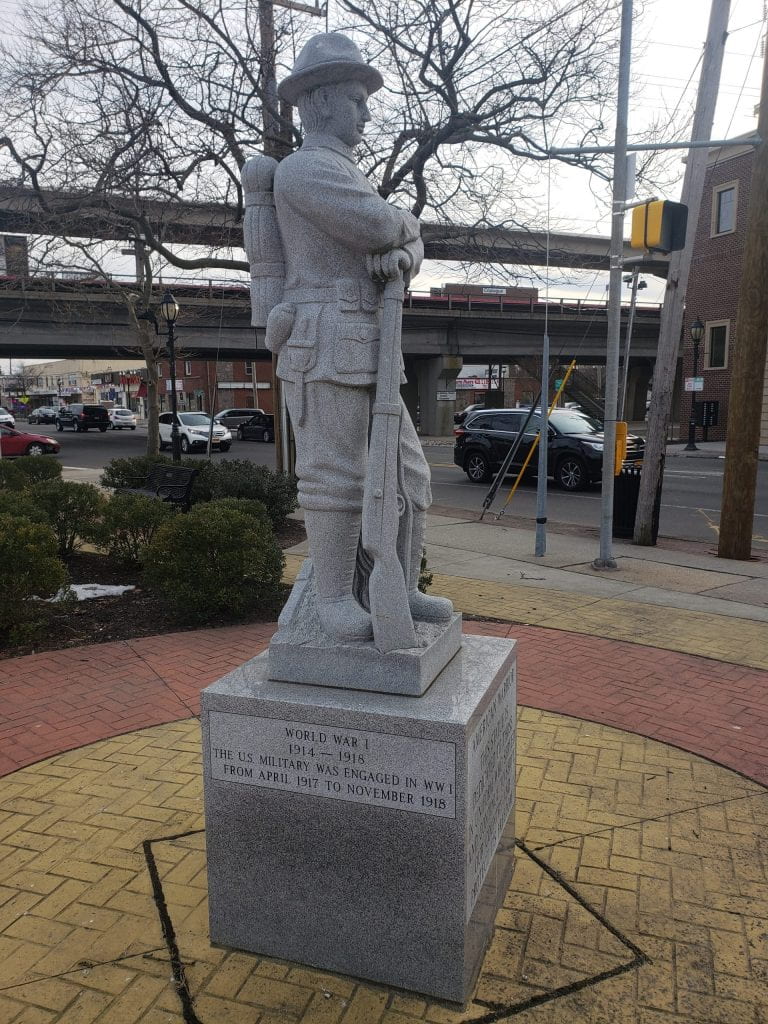In spring 2021, students in English 309 studied the history and literature of World War I. A few students elected to fulfill Stony Brook’s experiential learning requirement (EXP+) by visiting, researching, and writing about a WWI memorial on Long Island. In the first of these posts, English major Jun-Yi Wu writes about a Copiague memorial.
An unnamed American soldier stands 11-feet tall north of the Copiague train station on a piece of land named the “Veterans Memorial Plaza.” Behind him, a marker lists the names of Italian-American soldiers who fought during World War I. The Veterans Plaza Memorial dates back to the 1920s, a couple of years after the end of WWI, but on December 15, 2015, a doughboy statue was erected, and renovations were made to the old veterans plaza.
From August of 1914 to November of 1918, the world witnessed one of the largest and most influential wars it has ever seen. The battles during WWI not only changed the landscape of Europe due to trench warfare, but they also damaged civilization and would forever change Europe’s thoughts about the principles of constitutionalism, the rule of law, and representative government. Soldiers in Europe began to resent their government for making them fight in a war that they believed would be honorable. Instead, war tactics evolved during WWI, and soldiers had to suffer surprise attacks, unbearable weather conditions, and chemical warfare. English poet Robert Graves, who fought in the war, wrote in an article in The Observer that the trenches were “like air-raid shelters hastily dug in a muddy field, fenced by a tangle of barbed wire, surrounded by enormous craters; subjected not only to an incessant air-raid of varying intensity, but to constant surprise attacks by professional killers, and without any protection against flooding times of heavy rain.” WWI would forever change the way that countries fought war, and it would heavily influence the way that war was fought during WWII.
However, in the United States, the First World War is often overshadowed by the Second World War. Even though WWI lasted for four years, most Americans wanted to remain neutral in the war, so the U.S. did not enter the war until April of 1917. For the majority of WWI, the United States kept their distance from the war while supplying goods and ammunition to the Allied Powers. Although WWI is often overshadowed by the WWII, military historian John Keegan argues that the Great War sparked “a legacy of political rancor and racial hatred so intense that no explanation of the causes of the Second World War can stand without reference to those roots.” The war tactics of Nazi-Germany—the gas chambers, barbed-wire concentration camps, and blitzkriegs—are as much relics of the First World War as they are of the Second.
It is important to remember the wars and honor the veterans to not only appreciate their courage but to also let people learn from the catastrophes of war. In the 1920s, Copiague constructed the WWI Immigrant Memorial, a marker with the names of Italian-Americans from Long Island who fought in WWI.
The Immigrant Memorial is important because it acknowledges those veterans who had hybrid identities during a time of international conflict. During this time, mistaken loyalties would get innocent people in trouble with the authorities. Rudyard Kipling, an English poet who wrote propaganda for the British government, recognized the danger of mistaken identity in his short story “Mary Postgate,” which contains a scene of a British woman refusing to help an individual who she believed was German.
These stories of mistaken loyalties are not uncommon in reality. Take, for example, Leopoldo Cobianchi, an Italian-American who in 1917 was arrested on charges of espionage. Later, after protest from the Italian-American community, officials realized there had been a terrible misunderstanding when they found out that Cobianchi was a student preparing for the Yale Law School entrance exam. They found a rational explanation for each piece of evidence presented against him and the case was dismissed before it was ever tried in court.
Although Italian-Americans strongly supported the Allied cause during WWI, they were still subject to complicated cultural and political pressure. Christopher Sterba writes in the Journal of American Ethnic History that “the war confronted them as Americans, as persons still deeply attached to the Old World, and as ethnic newcomers.” It’s not difficult to imagine the social pressure that the Italian-Americans faced despite supporting the war effort by signing food pledge cards and buying Liberty bonds just like any other Americans at that time. That’s why monuments that recognize immigrants in the U.S. who fought in the war, like the Copiague Immigrant Memorial, are so important to us today.
In addition to the Immigrant Memorial, the Veterans Plaza Memorial also recently erected a doughboy statue to honor all veterans. “Doughboy” is a nickname that was given specifically to U.S. Soldiers during World War I but was first used during the American Civil War when it was applied to the brass buttons on the uniforms of infantrymen. The origins of the term are uncertain and often disputed. Some believed that it was derived from the “dough-like appearance of a uniform soiled by moistened pipe clay” or that the term came from the fact that infantrymen were said to “march in ‘dough’ during wet weather.” The earliest use of the term to refer to an American infantryman in U.S. Army slang dates back to 1835, and the term eventually evolved to refer to any soldier in the U.S. Army.
“I saw other towns had a statue but ours didn’t, so I said, ‘Let’s do something.’ No one knows what a soldier from then was like,” said Korean War veteran John Farina, a member of the Babylon veterans community.
Town Councilwoman Jackie Gordon worked together with the veteran’s community of the Town of Babylon to commission a statue of a doughboy at the Veteran’s Plaza. She says that “The way we live now, there’s a war going on in another part of the world and we just go on business as usual. The hope is to bring awareness of the veterans and the sacrifices they and their families make.”
Gordon says that “it was important for us to have something here for all veterans—past, present, and future—to be recognized. We didn’t want anyone to feel left out,” so although the memorial plaza was originally dedicated in the 1920s for WWI veterans, Gordon insisted on designing the statue based off the “American Warrior,” so that all veterans will feel appreciated. John Farina says that he hopes that children passing by will learn about the wars and the sacrifices that the soldiers and their families have made, as he says, “This is a remembrance for all our veterans.”
References:
Bonilla, Denise M. “Town Unveils Vets’ Plaza with Doughboy Statue.” Newsday 17 Dec. 2015.
Bonilla, Denise M. “WWI Doughboy Statue Coming to LI Town.” Newsday 5 May 2014.
Cornwell, R. D. World History in the Twentieth Century. Longmans, 1969.
Keegan, John. The First World War . 1st American edition., A. Knopf, 1999.
Sterba, Christopher M. “‘More Than Ever, We Feel Proud to Be Italians’: World War I and the New Haven ‘Colonia,’ 1917-1918.” Journal of American Ethnic History 20.2 (2001): pp. 70–106.












Very informative.
شركة تنظيف مكيفات بالرياض
Good post! This is a very good blog that I will definitely come back to many more times this year! Thanks for the article.
among us
최고의 메이져 먹튀검증 이곳에서 즐기세요
여기가바로 먹튀검증 배팅의성지